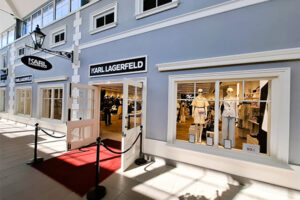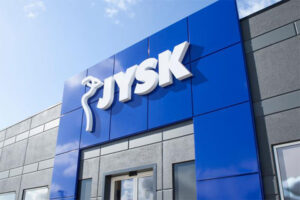ACROSS: Mrs. Hager, redos Group’s refurbishment of Rhein-Ruhr Zentrum in Mülheim an der Ruhr currently represents one of the largest projects of its kind in the German retail sector. More than 200 million euros will be invested in the complete refurbishment. Can shopping centers today keep up with the times in this era of ever-growing online consumption?
CHRISTINE HAGER: First and foremost, there is one particular feature that is in line with the times: excellent customer service. That is the major advantage that brick-and-mortar retail and, therefore, shopping centers have over online retail. With that in mind, the answer is quite clear: Yes, shopping centers are in line with the times – even more so than ever. The idea that online retailing is outpacing brick-and-mortar retailing is a common misconception. In Germany, for example, 82 percent of retail sales in the past year were generated by brick-and-mortar stores. That is not coincidental. People will always want to go shopping. However, there is one thing that is definitely true: Nowadays, retailers and shopping centers have to do much more to retain customers over the long term. Retail locations have to be transformed into worlds of experience that focus on visitors and their needs. That is precisely what we intend to do with Rhein-Ruhr Zentrum.
ACROSS: The design phase has been concluded. What exactly will the new Rhein-Ruhr Zentrum look like?
HAGER: Our aim is to create a destination in which shopping is just one of many options. Rhein-Ruhr Zentrum is set to become a place where visitors can shop, meet friends and acquaintances, and experience something. In short: a place in which visitors enjoy spending their leisure time and feel at ease. We would like to create somewhat of a second home for our customers. To that end, we have developed a completely new concept that combines various shopping, gastronomy, and leisure offers.
ACROSS: How can customer groups that have very different needs be addressed in an equal manner these days?
HAGER: One of the major challenges presented by the refurbishment of established locations is attracting new, often younger customer groups while retaining existing, regular customers. At 65 percent, for example, the share of regular customers at Rhein-Ruhr Zentrum is well above average. A great number of our customers have been loyal to us for decades. We want to and must continue to offer them opportunities to identify with “their” Rhein-Ruhr Zentrum. In the face of intense competition, such approaches are crucial for retail locations. Therefore, the future design of the center will also be based on the industrial character of the Ruhr region. In order to strengthen the center’s profile and appeal to new customers, we intend to increase the quality of our shopping and focus more intensively on gastronomy and entertainment.
ACROSS: What are your plans, in specific terms?
HAGER: A circuit that runs through the entire center will be created, the low ceilings will be opened in order to allow more natural light to enter the center, and, in addition to fast food and fine dining, a real marketplace will also be integrated – a unique feature of any shopping center in Germany to date. Offers such as these will serve to reinforce the character of Rhein-Ruhr Zentrum as a social meeting place. This will primarily enable us to reach younger generations: They want to meet their friends and experience something special in everyday life. The internet is unable to offer them that. One key point involves designing new services and leisure time activities in such a way that they can be seized during the day as well as in the evening. This will allow shopping centers to prolong their visitors’ length of stay.
ACROSS: What types of digital offers do modern centers need to provide in order to excite or amaze their customers?
HAGER: Service offerings such as free Wi-Fi and Click & Collect were innovative and unique a few years ago. Today, they are considered standard, although there are still a few shopping centers that do not offer these basic services. In a great number of places, retailers need to develop a better understanding of their customers. We need offers that allow our customers to tailor their shopping experiences to their individual needs.
ACROSS: What exactly do you mean?
HAGER: Imagine being able to use the interactive label scanners in changing rooms to order goods, in the right size, and have them delivered directly to your home. Another example would enable you to use built-in cameras that provide social media access to let your followers directly participate in the decision-making process via the various platforms, e.g., deciding what color sweater suits you best. Many more customizable offers such as these, which combine shopping, social interaction, and an experience factor, are needed. So far, they have remained the exception at centers.
ACROSS: What needs to be done in order for that to change?
HAGER: On the one hand, this will definitely require even closer cooperation among owners, operators, and tenants. Location concepts have to be considered in an all-encompassing manner. At present, most brands only implement their individual digitization strategies. Consequently, that means that customers currently have to go to each individual retailer’s website if, for example, they want to look up which store in their area has a particular pair of pants in stock. Naturally, this only works if the retailer in question provides information on its website.
ACROSS: Why shouldn’t customers simply order their pants directly from online shops?
HAGER: Because even during these times of delivery-on-demand, they have to endure waiting times. However, if, for example, customers could find out via the website of the nearest shopping center that a desired product was available there in the right size, I am convinced that many of them would choose this option. After all, in Germany, the nearest center can be reached by any customer within about 30 minutes.
ACROSS: What prerequisites would have to be put in place for this?
HAGER: Every tenant would have to make their product ranges available to the operator in order to enable customers to browse through and reserve all available products via the center’s website, and then pick them up from the local dealer. That is the only way the “Digital Mall” principle can work. Unfortunately, a great number of retailers do not share this opinion yet. Many still see digitalisation as a threat or constraint. However, one factor ranks above everything else: a tremendous opportunity to grow closer to the customer than before. In the future, retailers will have to make much more consistent use of the resources and opportunities available to them within the framework of digitalisation. This will enable them to play an active role in shaping the transformation of the industry.





